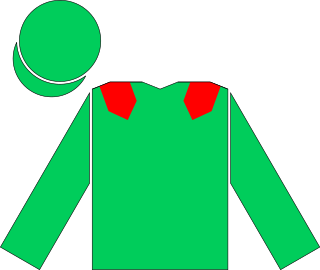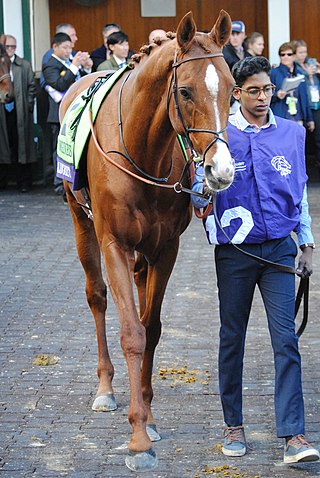Related Research Articles

Gérald Mossé is a jockey in thoroughbred horse racing. He began riding professionally in April 1983. His success during his apprenticeship under Patrick-Louis Biancone led to an offer to ride for renowned trainer François Boutin. His stable of horses belonging to Jean-Luc Lagardère. Mossé went on to become one of his country's top jockeys, winning the 1990 Prix de l'Arc de Triomphe. In 1991, he rode Arazi to five straight wins in France then spent 1992 and part of 1993 racing in Hong Kong.
Vaguely Noble (1965–1989) was an Irish-bred Thoroughbred racehorse who competed in the United Kingdom and France. The colt is best known as the winner of the 1968 Group One Prix de l'Arc de Triomphe when he defeated the best horses from England, France, Ireland and Italy. He was later a leading sire in Great Britain & Ireland and a Leading broodmare sire in GB & Ireland. Vaguely Noble is one of the highest-rated horses ever to run in Europe.

Blushing Groom was a French champion Thoroughbred racehorse and sire.

Tikkanen was an American Thoroughbred racehorse who competed internationally.
Strawberry Road was a champion Australian Thoroughbred racehorse who went on to race in Germany, France, the United States, and Japan. Bred in New South Wales, he was by the 'superbly-bred' Whiskey Road out of Giftisa.
Opening Verse (1986–2002) was a Thoroughbred racehorse who competed in England and the United States.
Darshaan was a British-bred, French-trained Thoroughbred racehorse and a Champion sire and broodmare sire.
Miswaki was an American-bred Thoroughbred racehorse that was a Group One winner in France and a stakes race winner in the United States. He was an important sire of 97 stakes race winners and was the Leading broodmare sire in Great Britain and Ireland in 1999 and 2001.
Flying Water was a French Thoroughbred racehorse. In a racing career that was disrupted by injury, she ran eleven times and won six races between July 1975 and June 1978. After winning her only race as a two-year-old, she won the Classic 1000 Guineas at Newmarket Racecourse in the spring of 1977. Having missed the second half of her three-year-old season through injury, she returned in 1978. She defeated leading sprinters in the Prix Maurice de Gheest, mile specialists in the Prix Jacques Le Marois, and middle-distances horses in the Champion Stakes. In 1978, she was sent to race in the United States where she was killed in an accident in a race at Belmont Park on 25 June.

Sendawar was an Irish-bred, French-trained racehorse, who is an active National Hunt Stallion. He was ridden by Gérald Mossé in all his starts.

Carroll House was an Irish-bred, British-trained Thoroughbred racehorse and sire. In a racing career which lasted from September 1987 until July 1990 he raced twenty times in six countries and won seven races. His most important win came in October 1989 when he won the Prix de l'Arc de Triomphe in Paris. His other wins included the Phoenix Champion Stakes, Grosser Preis von Baden, Princess of Wales's Stakes, Furstenberg Rennen and Welsh Derby. At the end of his racing career he was retired to become a breeding stallion in Japan and Ireland but had little success as a sire of winners.
Polar Falcon was an American-bred, French-trained Thoroughbred racehorse and sire. Unraced as a two-year-old he showed promising form at three while appearing to be slightly below top class. He reached his peak as a four-year-old when he won the Prix Edmond Blanc in France before taking two major prizes in England. In May he defeated the leading filly In The Groove in the Lockinge Stakes over a mile and in September he beat a strong field to win the Ladbroke Sprint Cup over six furlongs. As a breeding stallion he is best known as the sire of Pivotal. He died in 2001 at the age of fourteen.
Sanglamore was an American-bred, British-trained Thoroughbred racehorse and sire. In a racing career disrupted by injury, he won four of his eight races between November 1989 and July 1991. After finishing second in his only race as a juvenile in 1989, he emerged as one of the leading colts of his generation in the first half of the following year, winning the Dante Stakes in England and the Prix du Jockey Club in France. After a lengthy break, he returned as a four-year-old to win the Prix d'Ispahan and place in both the Eclipse Stakes and the King George VI & Queen Elizabeth Stakes. He was retired to stud at the end of the year but made little impact as a breeding stallion.
Distant Relative was an Irish-bred British-trained Thoroughbred racehorse and sire. After running fifth on his debut he never finished unplaced again ending his racing career with a record of eight wins and nine places from eighteen starts. He emerged as top-class miler in 1989, recording wins in the Phoenix International Stakes, Hungerford Stakes, Celebration Mile and Challenge Stakes. He was even better as a four-year-old in 1990, winning the Sussex Stakes and the Prix du Moulin. He was also placed in many important races including the Irish 2000 Guineas, Queen Elizabeth Stakes and Prix Jacques Le Marois. On his retirement from racing he stood as a breeding stallion and had some success as a sire of winners. He died in Turkey in 2005 at the age of nineteen.
Sunshack is a British-bred Thoroughbred racehorse and sire who was trained in France and the United States. He showed very good form as a two-year-old in 1993 when he won two of his four races including the Critérium de Saint-Cloud. In the following year he struggled for form before ending his season with a win in the Prix du Conseil de Paris. He reached his peak as a four-year-old in 1995 when he won the Prix Jean de Chaudenay, defeated a world-class field in the Coronation Cup and then stepped up in distance to take the Prix Royal-Oak. His later career was limited by injury and he failed to win again. He stood as a breeding stallion in Japan and France with very little success.
Lycius was an American-bred, French-trained Thoroughbred racehorse and sire. He showed excellent form as a juvenile in 1990, finishing second in the Prix de la Salamandre before traveling to England to win the Group One Middle Park Stakes. In 1991 he recorded a string of top-class performances without managing to win again: he finished second in the 2000 Guineas, July Cup and Prix Jacques Le Marois and third in the Irish 2,000 Guineas and Prix du Moulin. He was retired at the end of the year and had some success as a breeding stallion.
Priory Belle was an Irish Thoroughbred racehorse and broodmare. She showed her best form as a two-year-old in 1995 when she won two of her three races including the Group 1 Moyglare Stud Stakes. She failed to win in three starts in 1996 and was retired to become a broodmare. She had some success as a dam of winners, with the last of her foals being born in 2005.
Sikeston was an American-bred, British-trained Thoroughbred racehorse who had his greatest success in Italy. In five years on the track, he ran 34 times and won 11 races, seven of them at Group 1 level, three at Group 2 and one at Group 3 and was also placed in several major races. He produced most of his best performances on soft or heavy going. He won the Gran Criterium as a two-year-old in 1988 and the Premio Parioli in the following spring. As a four-year-old in 1990 he won the Premio Natale di Roma, Premio Ribot and Premio Vittorio di Capua. In the following season he took the Premio Vittorio di Capua for a second time as well as the Premio Presidente della Repubblica, Queen Anne Stakes and Premio Roma. In his final season on the track he won a second Premio Presidente della Repubblica and the Irish International Stakes.
Valanour was an Irish-bred, French-trained Thoroughbred racehorse and sire. He did not race as a juvenile but as a three-year-old in 1995 he was one of the best colts of his generation in France, winning three races including the Prix de Guiche and the Grand Prix de Paris. In the following spring he won the Prix d'Harcourt and the Prix Ganay but was unplaced in his last two races and was retired at the end of the year with a record of five wins from nine starts. He had limited success as a breeding stallion and died in 2018.

Waldgeist is a British-bred, French-trained Thoroughbred racehorse. He has raced in six countries, namely France, Ireland, the United Kingdom, Germany, the United States and Hong Kong. He showed top-class form as a two-year-old in 2016 when he won two of his three races including the Group 1 Critérium de Saint-Cloud. He failed to win in the following year but ran second in the Prix du Jockey Club and fourth in the Irish Derby. In 2018 he won four consecutive races, namely the Prix d'Hédouville, Grand Prix de Chantilly, Grand Prix de Saint-Cloud and Prix Foy. In 2019 he won a third Group 1 race when he took the Prix Ganay and recorded his biggest win in October when he took the Prix de l'Arc de Triomphe.
References
- ↑ "Priolo - Progeny". Racing Post.